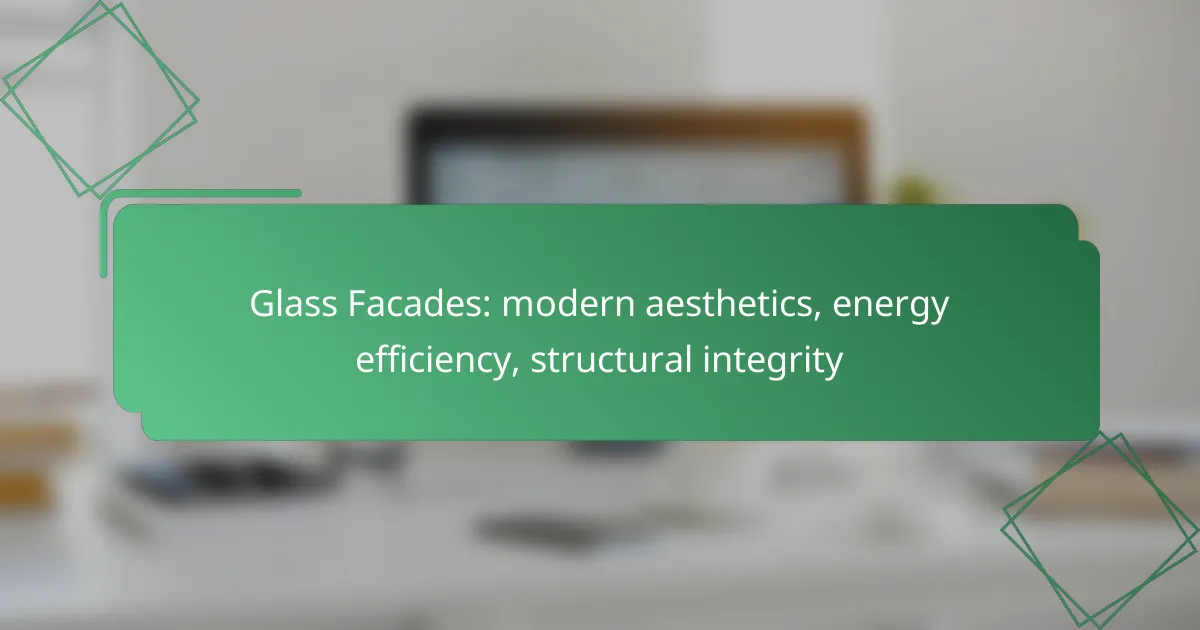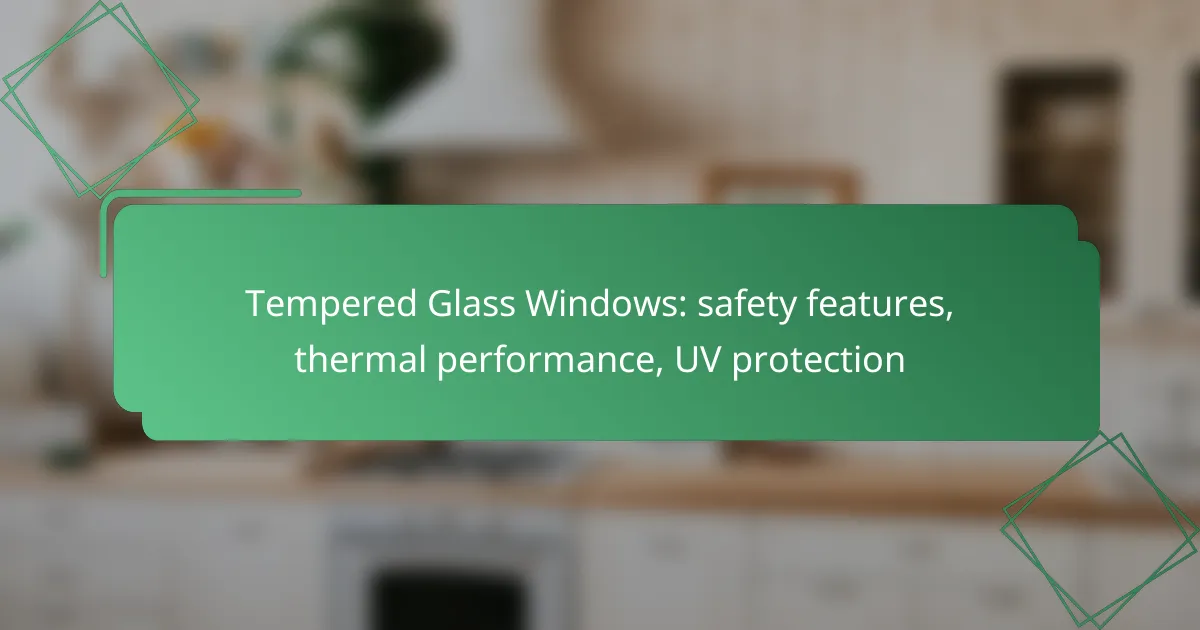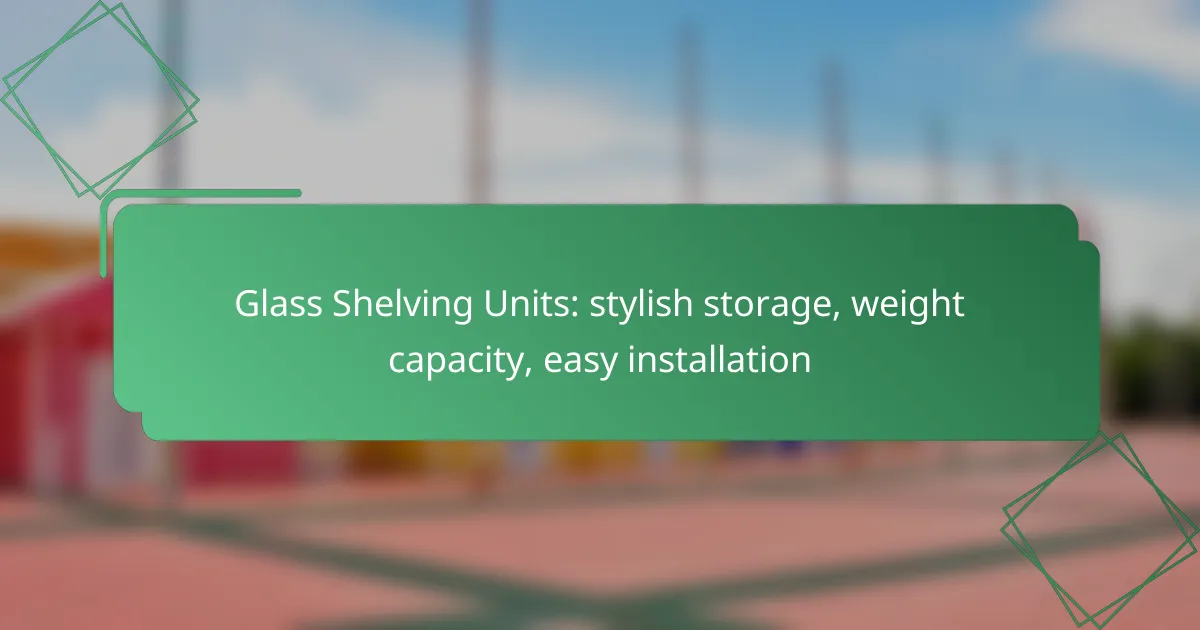Glass balustrades are a perfect blend of safety compliance and design elegance, adhering to stringent standards to ensure structural integrity and user safety. Their sleek, transparent design not only enhances the aesthetic appeal of various architectural styles but also provides unobstructed views and increased natural light, creating a sense of openness in any space.

What are the safety compliance standards for glass balustrades in Canada?
In Canada, glass balustrades must adhere to specific safety compliance standards to ensure structural integrity and user safety. These standards encompass building codes, glass thickness specifications, and load-bearing capacities, all of which are critical for effective installation and use.
Building Code requirements
The National Building Code of Canada (NBC) outlines essential requirements for glass balustrades, focusing on safety and structural performance. Compliance with these codes ensures that balustrades can withstand various environmental factors and loads, including wind pressure and impact forces.
Local municipalities may have additional regulations that must be followed, so it is crucial to check with local building authorities before installation. Ensuring compliance with these codes helps prevent accidents and legal issues.
Glass thickness specifications
Glass thickness is a critical factor in the safety of balustrades. In Canada, tempered glass used for balustrades typically ranges from 10 mm to 15 mm in thickness, depending on the height and application of the balustrade. Thicker glass provides greater strength and resistance to breakage.
When selecting glass thickness, consider the height of the balustrade and the potential impact forces it may encounter. Consulting with a structural engineer can help determine the appropriate thickness for specific installations.
Load-bearing capacity
The load-bearing capacity of glass balustrades is essential for ensuring safety under various conditions. Canadian standards require that balustrades can support a minimum horizontal load, typically around 1.5 kN/m, which translates to the weight of several adults leaning against it.
It is important to assess the specific load requirements based on the intended use of the balustrade. Regular inspections and maintenance can help ensure that the balustrade continues to meet safety standards over time.

How do glass balustrades enhance design elegance?
Glass balustrades enhance design elegance by offering a sleek, modern look that complements various architectural styles. Their transparency allows for unobstructed views, creating a sense of openness while maintaining safety and functionality.
Modern aesthetic appeal
Glass balustrades are synonymous with contemporary design, providing a clean and sophisticated appearance. Their minimalist profile can elevate both interior and exterior spaces, making them a popular choice for homes, offices, and public buildings.
Incorporating glass balustrades can significantly enhance the visual appeal of staircases, balconies, and terraces. The reflective quality of glass can also create interesting light effects, adding to the overall ambiance of a space.
Customization options
Glass balustrades can be tailored to fit specific design preferences, including various thicknesses, tints, and finishes. Options such as frosted or etched glass can provide privacy while still allowing light to permeate the area.
Additionally, hardware choices like stainless steel or aluminum fittings can further customize the look, ensuring that the balustrade aligns with the overall design theme of the property. Homeowners can choose between frameless or framed designs based on their aesthetic goals and safety requirements.
Integration with architecture
Glass balustrades integrate seamlessly with a wide range of architectural styles, from modern to traditional. Their versatility allows them to complement various materials, such as wood, stone, or metal, enhancing the overall design coherence.
When planning for integration, consider the surrounding elements, such as railings or walls, to ensure a harmonious look. Proper installation is crucial; ensure that the balustrades meet local building codes and safety standards to maintain both elegance and compliance.

What visibility benefits do glass balustrades provide?
Glass balustrades offer significant visibility benefits by providing clear sightlines and enhancing natural light in both residential and commercial spaces. Their transparent design allows for unobstructed views, making areas feel more open and connected.
Unobstructed views
One of the primary advantages of glass balustrades is their ability to provide unobstructed views. Unlike traditional materials, glass does not block sightlines, allowing for a seamless transition between indoor and outdoor spaces. This is particularly beneficial in settings like balconies or staircases where maintaining a visual connection to the surroundings is desired.
When selecting glass balustrades, consider the thickness and type of glass used. Tempered or laminated glass is recommended for safety and durability while ensuring clarity. Regular maintenance, such as cleaning, will also help preserve the transparency and aesthetic appeal.
Natural light enhancement
Glass balustrades significantly enhance the flow of natural light within a space. Their transparent nature allows sunlight to penetrate deeper into interiors, reducing the need for artificial lighting during the day. This can create a more inviting atmosphere and potentially lower energy costs.
To maximize light enhancement, position glass balustrades in areas where they can reflect and diffuse sunlight effectively. Avoid placing heavy furniture or dark materials nearby that could absorb light and diminish the overall brightness of the area.
Safety visibility
Safety visibility is crucial when it comes to glass balustrades, especially in high-traffic areas. The transparency of glass allows for clear visibility of potential hazards, helping to prevent accidents. This is particularly important in environments such as public spaces, where safety regulations may require clear sightlines.
Ensure that glass balustrades meet local safety standards, which may dictate the height and thickness of the glass. Installing additional features, such as contrasting colors or textures at the base, can further enhance visibility and safety, especially for individuals with visual impairments.
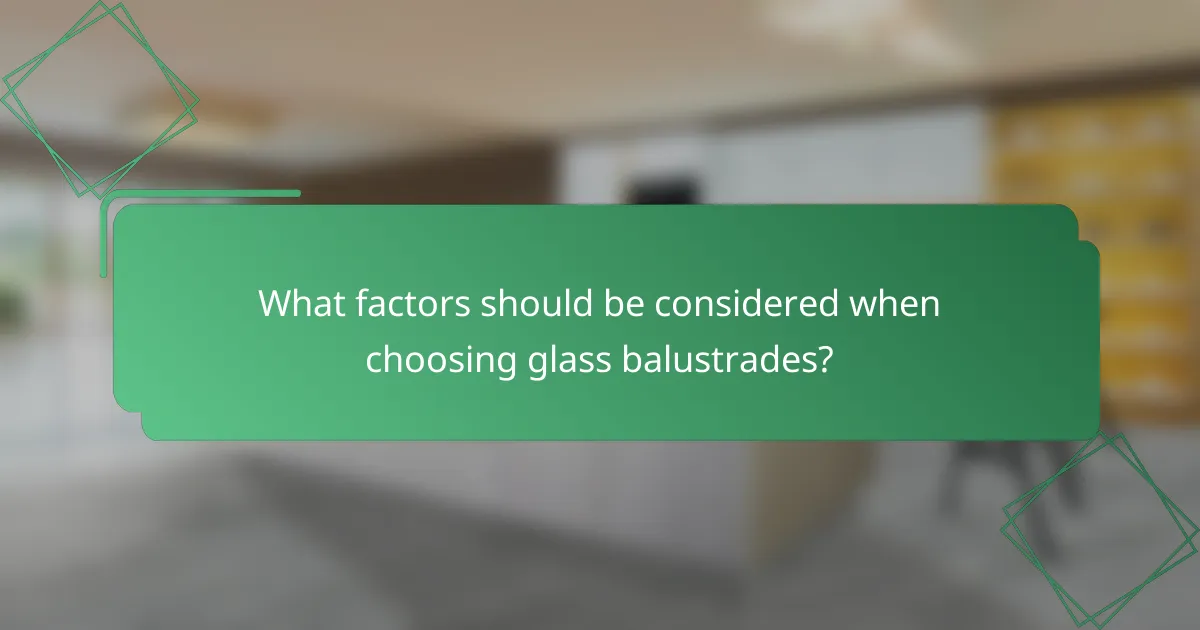
What factors should be considered when choosing glass balustrades?
When selecting glass balustrades, it’s essential to consider material quality, design compatibility, and local climate conditions. These factors ensure safety, aesthetic appeal, and durability, making your choice both practical and visually pleasing.
Material quality
Material quality is crucial for the safety and longevity of glass balustrades. Opt for tempered or laminated glass, as these types are more resistant to impact and shattering. Ensure the glass meets relevant safety standards, such as those set by the International Organization for Standardization (ISO) or local building codes.
Additionally, consider the thickness of the glass; typically, a thickness of 10-12 mm is recommended for balustrades to provide adequate strength and support. Regular maintenance and cleaning can also prolong the life of the glass and keep it looking pristine.
Design compatibility
Design compatibility involves ensuring that the glass balustrades harmonize with the overall aesthetic of your space. Whether your style is modern, traditional, or minimalist, the balustrades should complement existing architectural elements. Consider the frame materials, such as stainless steel or aluminum, which can enhance the visual appeal.
Furthermore, think about the color and finish of the glass. Clear glass offers unobstructed views, while frosted or tinted options can provide privacy and a unique look. Always visualize how the balustrades will fit into your environment before making a decision.
Local climate considerations
Local climate plays a significant role in the choice of glass balustrades. In areas with extreme weather conditions, such as heavy winds or snow, ensure that the installation is robust enough to withstand these forces. Consult local building regulations to determine any specific requirements for wind load and structural integrity.
Additionally, consider the effects of UV exposure and temperature fluctuations on the glass. UV-resistant coatings can help prevent fading and degradation over time, ensuring that your balustrades maintain their appearance and functionality. Regular inspections can help identify any potential issues caused by local climate factors.

How do glass balustrades compare to other railing options?
Glass balustrades offer a unique blend of safety, design elegance, and visibility compared to traditional railing options. They provide unobstructed views while maintaining structural integrity, making them a popular choice for both residential and commercial spaces.
Glass vs. metal railings
Glass balustrades differ from metal railings in aesthetics and visibility. While metal railings can provide a sturdy barrier, they often obstruct views and can appear bulky. Glass, on the other hand, enhances the openness of a space, allowing natural light to flow and creating a sense of airiness.
In terms of maintenance, metal railings may require regular painting or treatment to prevent rust, especially in coastal areas. Glass balustrades, while needing occasional cleaning to maintain clarity, are generally more resistant to weather-related wear.
Glass vs. wood railings
When comparing glass balustrades to wood railings, the primary difference lies in durability and design. Wood railings can provide warmth and a classic look but are susceptible to rot, splintering, and insect damage. Glass balustrades, in contrast, are more resilient and can withstand various weather conditions without degrading.
Additionally, glass railings do not require the same level of upkeep as wood, which may need staining or sealing every few years. This makes glass a more practical choice for long-term use, especially in areas with high humidity or rainfall.
Cost comparison
The cost of glass balustrades can vary significantly based on factors such as thickness, type of glass, and installation complexity. Generally, glass railings can be more expensive upfront compared to metal or wood options, often ranging from $100 to $300 per linear foot, including installation.
However, when considering long-term maintenance and durability, glass may prove to be a cost-effective choice. Metal and wood may have lower initial costs but can incur additional expenses over time due to maintenance and replacement needs. Evaluating the total cost of ownership is crucial when selecting the right railing option for your project.
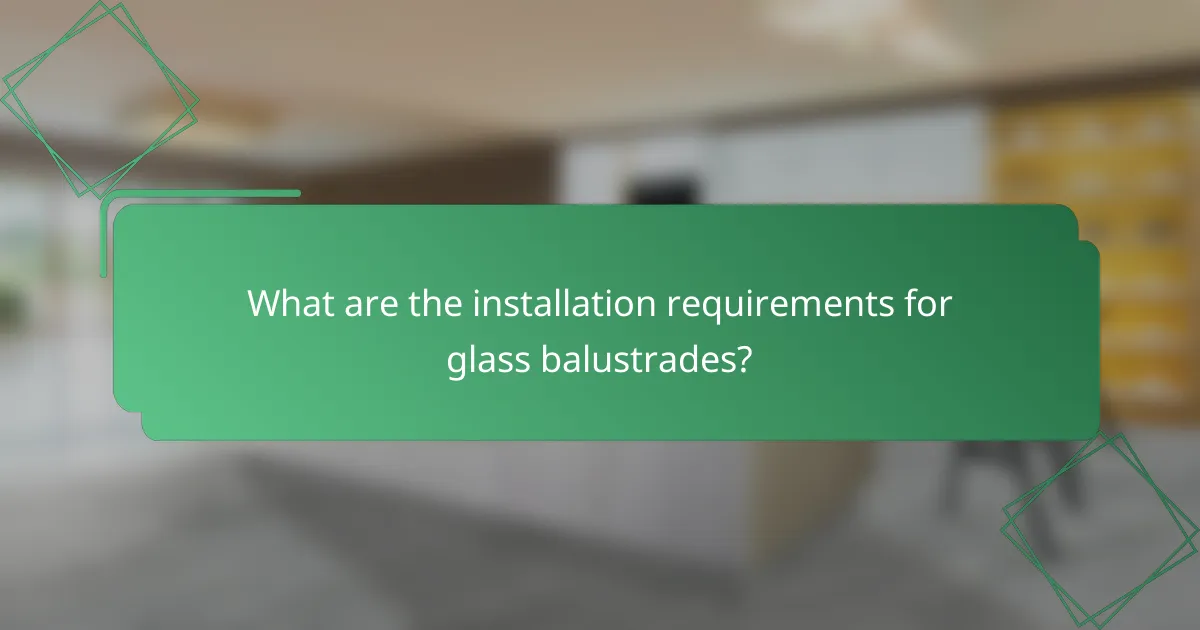
What are the installation requirements for glass balustrades?
Glass balustrades must meet specific installation requirements to ensure safety and compliance with local building regulations. These requirements typically include structural integrity, height specifications, and the use of appropriate materials.
Safety Standards
Safety standards for glass balustrades vary by region but generally include guidelines on the thickness and type of glass used. In many places, tempered or laminated glass is required to prevent shattering. Compliance with standards such as the International Building Code (IBC) or local regulations is crucial for ensuring safety.
Installation Height
The installation height of glass balustrades is typically regulated to prevent falls. Most jurisdictions require a minimum height of around 1 meter (approximately 39 inches) for residential applications. Always check local codes to confirm the exact height requirements for your area.
Structural Support
Proper structural support is essential for glass balustrades to withstand pressure and impact. The balustrade must be anchored securely to the floor or wall, and the mounting hardware should be rated for the weight of the glass. Consider consulting a structural engineer for complex installations.
Maintenance Considerations
Regular maintenance is necessary to keep glass balustrades safe and visually appealing. This includes cleaning the glass to prevent buildup of dirt and grime, as well as checking for any signs of wear in the hardware. A simple routine of inspection every few months can help identify potential issues early.







